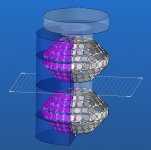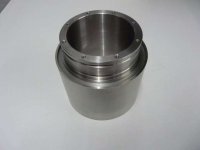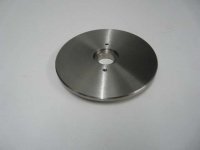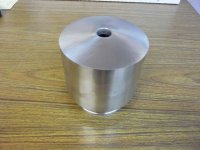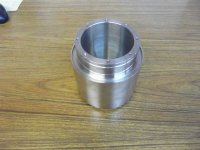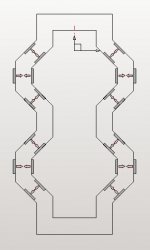I had a look to a system without any contacts, and I have drawned this. What do you think about it?
It uses 648 magnets (diameter=8mm, thickness=1mm), found here: supermagnete - S-08-01-N: Disque magnétique Ø 8 mm H 1 mm (total: 150 euros).
Did anyone tryed this kind of TT rotating unit?
It uses 648 magnets (diameter=8mm, thickness=1mm), found here: supermagnete - S-08-01-N: Disque magnétique Ø 8 mm H 1 mm (total: 150 euros).
Did anyone tryed this kind of TT rotating unit?
Attachments
I had a look to a system without any contacts, and I have drawned this. What do you think about it?
It uses 648 magnets (diameter=8mm, thickness=1mm), found here: supermagnete - S-08-01-N: Disque magnétique Ø*8*mm H*1*mm (total: 150 euros).
Did anyone tryed this kind of TT rotating unit?
Not to be a Debbie-Downer, but this is why the above sketch won't work:
Earnshaw's theorem - Wikipedia, the free encyclopedia
I've tried a different arrangement of the same basic idea, and it really isn't possible. It can be done with electromagnets and a control system though:
Magnetic bearing - Wikipedia, the free encyclopedia
By the way, I read this entire thread yesterday, and I have to say that both your quality of workmanship, and incredibly fast progress are second to none! Very impressive work!
I would need two hands to count the number of turntable projects I've started and not finished, but at least I can live vicariously through threads like this!
Best of luck with your project going forward.
Regards,
Owen
anyone tried this kind of TT rotating unit?
Very unlikely.
The outer shell of such a magnetic bearing will be a tour de force to manufacture, i'd think.
I made an attempt for a magnetic platter suspension on my DIY Verdier in the early '90s, turned out far more complicated than anticipated, copped out by reverting back to a traditional bearing.
If you're able to machine the most suitable iron, and get the calculations right, who knows.
Love your unrestrained creativity.
Jacco:
You're missing the point... it's physically impossible to make such an arrangement work, regardless of the precision of the machining or the placement of the magnets.
You can't suspend a mass in 3 dimensions using purely static magnets. The Clearaudio system works because they've mechanically restricted the platter in two dimensions using the ceramic sleeve bearing. That only leaves one dimension for the magnet to support, which is why it works.
Cheers,
Owen
You're missing the point... it's physically impossible to make such an arrangement work, regardless of the precision of the machining or the placement of the magnets.
You can't suspend a mass in 3 dimensions using purely static magnets. The Clearaudio system works because they've mechanically restricted the platter in two dimensions using the ceramic sleeve bearing. That only leaves one dimension for the magnet to support, which is why it works.
Cheers,
Owen
By the way, I read this entire thread yesterday, and I have to say that both your quality of workmanship, and incredibly fast progress are second to none! Very impressive work!
I would need two hands to count the number of turntable projects I've started and not finished, but at least I can live vicariously through threads like this!
Best of luck with your project going forward.
Regards,
Owen
Hi Owen, and thanks for support.
Hi Jacco,
Don't get me wrong; the basic idea of suspending the platter using a magnetic field is an excellent idea
I'm just trying to clarify that it can't be done using only permanent magnets.
A good solution would be to use a permanent magnet in a similar manner to Clearaudio, but replace the ceramic sleeve bearing with an active magnetic bearing. You could implement drive with the same system, and eliminate the belt as well! It would be a truly contact-less system (except the stylus of course).
Cheers,
Owen
Don't get me wrong; the basic idea of suspending the platter using a magnetic field is an excellent idea
I'm just trying to clarify that it can't be done using only permanent magnets.
A good solution would be to use a permanent magnet in a similar manner to Clearaudio, but replace the ceramic sleeve bearing with an active magnetic bearing. You could implement drive with the same system, and eliminate the belt as well! It would be a truly contact-less system (except the stylus of course).
Cheers,
Owen
This magnetic bearing works with a iron shaft, in may case, I will use small magnetic disks in force opposition, all around the shaft and also at 45° each side. If the shaft was only an iron OK, I can understand. Maybe I'm wrong. I'm a total newbie, so that's why I'd like to really understand.
Hi doitmyself,
Here are the two most pertinent quotes from the links I posted:
I know it looks like it makes logical sense, but it doesn't work. You either need an active control system to maintain stability, or you need to make whatever you plan to levitate out of a diamagnetic material.
The schematic you posted looks correct because you've only depicted the repulsive force of the magnets. Draw in the effects of the attractive sides of each magnet, along with the variations in the magnetic field caused by the shape of the magnets, and you'll quickly see why it's not a stable configuration
Regards,
Owen
Here are the two most pertinent quotes from the links I posted:
"Earnshaw's theorem states that a collection of point charges cannot be maintained in a stable stationary equilibrium configuration solely by the electrostatic interaction of the charges. This was first proven by British mathematician Samuel Earnshaw in 1842. It is usually referenced to magnetic fields, but originally applied to electrostatic fields. It applies to the classical inverse-square law forces (electric and gravitational) and also to the magnetic forces of permanent magnets and paramagnetic materials or any combination, (but not diamagnetic materials)."
"En physique, en électromagnétisme classique, le théorème d'Earnshaw établit qu'un ensemble de charges ponctuelles ne peut être maintenu dans un équilibre stable uniquement par des interactions d'ordre électrostatique entre les charges.
Le théorème fut prouvé pour la première fois en 1842 par Samuel Earnshaw. On l'utilise couramment pour les champs magnétiques, mais il fut à l'origine étudié pour les cas électrostatiques. Il s'applique en réalité à toute combinaison de forces qui suivent une loi en 1/(r^2): les effets des champs magnétiques, électriques ou gravitationnels."
"This theorem also states that there is no possible static configuration of ferromagnets which can stably levitate an object against gravity, even when the magnetic forces are stronger than the gravitational forces."
"Le théorème établit par ailleurs qu'il n'existe aucune configuration statique d'aimants qui permettrait la lévitation stable d'un objet contre la gravité, même si les forces magnétiques surpassent de beaucoup la force d'attraction gravitationnelle. La lévitation magnétique est cependant possible, si on peut faire varier le champ magnétique dans le temps."
I know it looks like it makes logical sense, but it doesn't work. You either need an active control system to maintain stability, or you need to make whatever you plan to levitate out of a diamagnetic material.
The schematic you posted looks correct because you've only depicted the repulsive force of the magnets. Draw in the effects of the attractive sides of each magnet, along with the variations in the magnetic field caused by the shape of the magnets, and you'll quickly see why it's not a stable configuration
Regards,
Owen
Last edited:
Hi doitmyself,
Here are the two most pertinent quotes from the links I posted:
I know it looks like it makes logical sense, but it doesn't work. You either need an active control system to maintain stability, or you need to make whatever you plan to levitate out of a diamagnetic material.
The schematic you posted looks correct because you've only depicted the repulsive force of the magnets. Draw in the effects of the attractive sides of each magnet, along with the variations in the magnetic field caused by the shape of the magnets, and you'll quickly see why it's not a stable configuration
Regards,
Owen
Pfffffffffff, it's dead so!!!?
Do I have to forgive the idea of magnetic shaft?I don't understand either of the last two posts
Not necessarily... you just have to re-think your approach 
There's a free finite element magnetic modeller called FEMM that you can download here:
Finite Element Method Magnetics: HomePage
That would be a good place to start. There's an example included with the program that is a radial magnetic bearing.
Cheers,
Owen
There's a free finite element magnetic modeller called FEMM that you can download here:
Finite Element Method Magnetics: HomePage
That would be a good place to start. There's an example included with the program that is a radial magnetic bearing.
Cheers,
Owen
Not necessarily... you just have to re-think your approach
There's a free finite element magnetic modeller called FEMM that you can download here:
Finite Element Method Magnetics: HomePage
That would be a good place to start. There's an example included with the program that is a radial magnetic bearing.
Cheers,
Owen
OK, I'll take a look. I have found this:
http://tel.archives-ouvertes.fr/docs/00/56/92/74/PDF/these-allag-udg.pdf
t's in French but some parts are interesting (page 26).
Thanks Owen
Hi Doitmyself. With all respect to physical scientists, many ideas were considered crazy, and they have worked later. As an example, I'm pretty shure the very idea of the single blow-back weapon were considered crazy at the time of muzzle loaders and early breach loaders, and authors could be placed into the special institution... The idea of recording sound was kinda damned by the French Academy Of Science. In your place, having access to CNC machines, I would try several experimental designs, and who knows... At least, I tried to heavily upgrade my vintage MICRO turntable, despite my friend's (who has Ph.D in both physics and electronics) opinion, that my ideas absolutely will not work. However, it worked from the first trial, and it still works 6 years later, and difference in sound quality is really huge- bigger, than just playing with cables, belts and power supply- things that usually are done.
Last edited:
- Status
- This old topic is closed. If you want to reopen this topic, contact a moderator using the "Report Post" button.
- Home
- Source & Line
- Analogue Source
- DIY Personal Turntable
